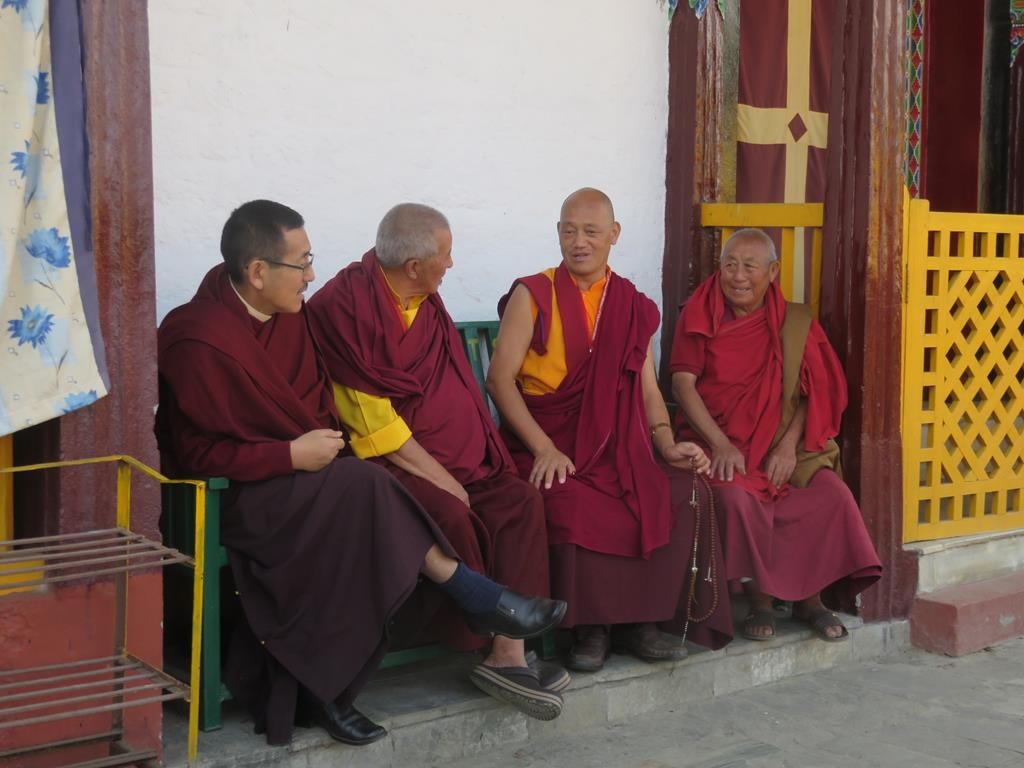Our trip through northern India takes us to Varanasi the Holiest city, a stunning and truly unparalleled destination, considered the cradle of Hinduism. Perhaps we cannot define it as the cleanest, most beautiful, and orderly city, but we can define it as the most authentic. Visiting Varanasi is like diving into the heart of India and understanding this fascinating country a little more.
Therefore, our advice is that you do not leave Varanasi out of your itinerary, the city surprises at every moment. To organize the trip you have this complete guide that we have prepared for you.
The name Varanasi comes from its location between the Assi and Varuna rivers, although the real protagonist here is the Ganges River. The Ganges is the sacred river of Hinduism and the place where every Hindu hopes his ashes will be scattered when he ends his earthly life. This makes Varanasi an extremely spiritual city, to the point that it is considered the most sacred city in India.
Varanasi could be said to revolve around the passage of the Ganges River through it. Therefore, it should be visited from the river, either by taking a boat ride (monsoon permitting) or by watching life from the ghats.
But, before we dive into the most sacred city in India, we give you some practical information. Varanasi, as you already know, is located on the banks of the Ganges River, 862 km from the capital, New Delhi, and about 600 km from Agra. Nearby is the state’s border with Bihar, while to the north is the border with Nepal, near the city of Lumbini (the place where Buddha was born).

- Why is it considered the most sacred city in India?
- How to get to Varanasi?
- What to do in Varanasi?
- Discover the ghats of the Ganges River
- Take a boat ride on the river
- Visit one of the Hindu temples in Varanasi
- Other places to see in Varanasi
- Excursion to Sarnath
Why is it considered the most sacred city in India?
For Hinduism, Varanasi is the most sacred of the seven sacred cities of India (it would be like Jerusalem for Christians). It is also the oldest inhabited city in the world, whose history began to be written 5,000 years ago. The reasons why it is considered the most sacred in Hinduism are many, and we will tell you about them below more about Varanasi the Holiest city.
For Hindus, the goddess Ganga gave life to humanity the moment she let her hair fall over the universe. That hair would represent the Ganges River, which is considered an extension of the god that causes life and death. The Ganges is possibly the most sacred river in the world. It descends from the peaks of the Himalayas and ends in Calcutta, passing through cities such as Haridwar, Allahabad and Varanasi.
Hinduism talks about reincarnation after death. Depending on how the person has behaved in his or her earthly life, it will be reincarnation into a higher, intermediate or lower existence. In this way, it is possible to reincarnate into a god, a person or an animal (even an insect).
Hindus believe that placing the ashes of a deceased person in the river waters prevents the cycle of reincarnation, allowing people to achieve Nirvana (the supreme goal of Hinduism). For this reason, people who seek to purify themselves bathe daily on its shores (something that may seem contradictory given the putrefaction of its waters, although for them it is loaded with symbolism).
Day after day, Hindus travel to the city of Varanasi to carry out the ritual of cremation of the bodies of the deceased at the ghats. In this way, by scattering the ashes in the sacred river the person is able to reintegrate into the divine energy and avoid reincarnation. In other words, whoever ends his life in the Ganges manages to free his soul from the cycle of birth, death and reincarnation.
Therefore, the most important experience you can have in Varanasi is to travel the Ganges and witness the most sacred ritual of Hinduism.
A few kilometers north of Varanasi, in the city of Sarnath, Buddha is said to have given his first sermon after achieving enlightenment through meditation. This is another reason why Varanasi is considered the holiest city in Hinduism, but there is more.
According to belief, one of the four heads of the God Brahma (one of the main gods of Hinduism) came to rest in this city. On the other hand, it is said that the left hand of the wife of the god Shiva fell in Varanasi. Be that as it may, tradition dictates that every Hindu should visit this place at least once in his life and purify his soul.

How to get to Varanasi?
Virtually all travelers arrive in Varanasi by train and plane.
As we have already mentioned in other articles, the train is one of the best means of transportation in India. That way, you can reach Varanasi from New Delhi, Agra and Mumbai. The central station is Varanasi Junction, although some trains also make stops at Mughal Sarai, 18 km from the city centre.
Traveler tip: the best alternative to get to Varanasi the Holiest city is to take the night train from New Delhi or Agra.
Another alternative is to arrive by plane, as Varanasi has more and more connections with other Indian cities (for example, Mumbai, Delhi and Bengaluru). You also have low cost companies, such as Indigo and Spicejet. From the airport it is approximately an hour’s transfer to the city center, although it can be longer during rush hour. Most travelers choose to overcome this distance in taxis or by hiring a private transfer to the hotel.
Once in Varanasi, the main means of transport are rickshaws and tuk-tuk, which can take you from the center to the ghats, although they cannot access the old town area. A good way to get to know the city is to walk along the banks of the Ganges River. The ghats of the city are interconnected, so we suggest starting at Harischandra Ghat and moving south to Assi Ghat, where you will find the most relaxed part of the city.
Also, you can hire a taxi to travel to Sarnath, a sacred city for Buddhism.

What to do in Varanasi?
There is a lot to do in Varanasi: witness fire rituals and religious ceremonies from the ghats, visit sacred temples, etc. Without a doubt, it is the right city to learn about the culture and spirituality of India.
Visiting Varanasi can be a shocking experience, since you face the poorest side of India. But, beyond that, its chaos and dirt, it is a destination that any traveler should visit at least once in their life.
At the same time, a visit to Varanasi allows you to take a trip back in time and learn more about the history of the country and discover ancient traditions. Therefore, a suggestion is to dedicate at least 2 full days to this intense and exciting city.
Before telling you everything you can see and do in the most sacred city in India, we leave you these tour options offered by Delighted Journey:
- Explore the villages around Varanasi and learn more about the Hindu way of life with this private tour of Varanasi villages. You can opt for an 8 or 4 hour walk, it’s your choice.
- Discover the most emblematic corners of the city with this free tour of Varanasi or with this private tour of Varanasi.
- Are you a fan of Social Networks? Then this Varanasi Instagram tour is perfect for you.
- Travel the city streets on India’s most popular means of transportation with this tuk tuk tour of Varanasi.
Now let’s see what to do in Varanasi.

Discover the Ghats of the Ganges River
Along with the Ganges River, the ghats are another of the major points of interest in Varanasi. What are they? A series of stairs or steps that access the sacred waters of the river. In the 6 km of length through which the Ganges passes, there are around 90 ghats where locals gather to wash their clothes, bathe in the river or deposit the ashes of their dead.
Each ghat is dedicated to a different deity and is full of small temples that appear behind a thick layer of incense. The ghats are meeting points for both tourists and locals and places loaded with symbolic elements. You could say that there you will see India at its best.
A clarification that we believe is important to make (although you may have already reached this conclusion on your own), is that it is in no way recommended to bathe or drink river water. The fact that it is a sacred place does not free it from the heavy pollution to which it is unfortunately exposed.

Manikarnika and Harischandra ghats
Cremations take place at the Manikarnika (one of the largest) and Harischandra (one of the smallest) ghats.
The first is the most important in the city and is dedicated to the god Shiva. It can be reached from Jalasen Ghat, after passing through the Nepalese temple. If you come from the old city, access is through a series of labyrinthine alleys through which funeral processions pass.
Both in the ghat and in the access alleys you will see piles of different types of wood. Each one has its price and contributes to the improvement of the karma of the deceased. For example, a sandalwood pyre is more expensive, but gives the deceased better karma than other types of cremations.
The bodies of the deceased arrive here wrapped in sheets, to then be immersed in the sacred waters of the river and later cremated. The family, sitting on the ghats, watch the bodies burn and wait until they can throw the ashes into the river and give their loved one eternal rest.
Keep in mind that these are private ceremonies, so tourists are asked to have the utmost respect, keep a safe distance and avoid taking photos. What for some is a tourist “attraction”, for others it is an intimate moment full of emotions. If you find that the situation is beyond you, you can continue your walk through the ghats, since there is much more to see.
Did you know that this ghat has a curious legend? According to it, the goddess Parvati (Shiva’s wife) had grown tired of the god of destruction leading her followers from one place to another. For this reason, she buried one of her earrings and told Shiva that she had lost it in the Ganges River. Shiva searched tirelessly for the pendant without success. Therefore, it is said that the souls of people who are cremated in Manikarnika meet Shiva, who asks them if they have seen the pendant.
At Harischandra, the smallest ghats intended for cremations, the electric crematorium is located. It was installed by the government with the aim of reducing the number of incinerations on the banks of the river and thus pollution. Despite this, it is usually empty because people prefer the traditional method.
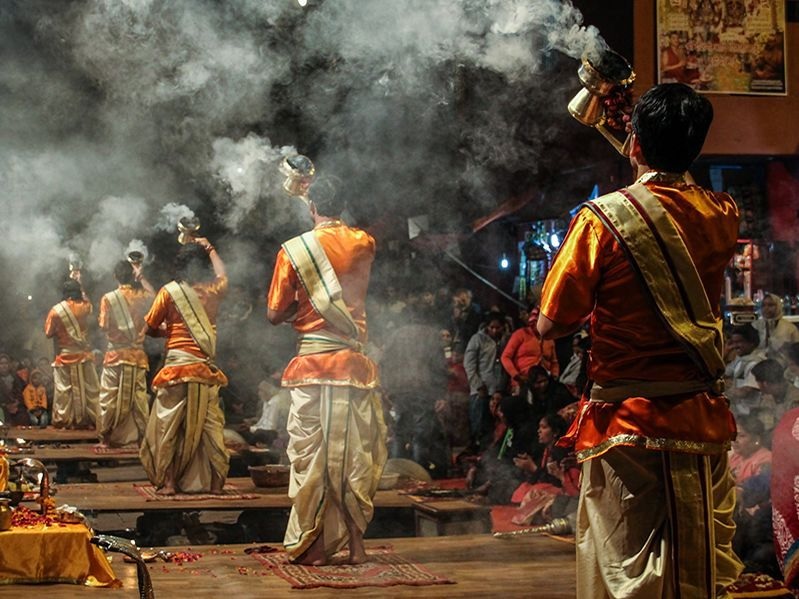
5 interesting facts about cremations in Varanasi
Cremations on the banks of the Ganges River are a novelty for tourists visiting Varanasi. Although most visit having previously read about them, it never hurts to have all the information possible. Therefore, we leave you 5 interesting facts about it.
- Only cremations of Hindus who have died naturally can be carried out in Manikarnika. The people who cannot be burned are those who die as a result of violence, pregnant women, children under 10 years old, lepers and those who have died from a cobra bite. For its part, in Harischandra cremations of other religions are allowed, except Muslims.
- More than 175 bodies are cremated every day in Varanasi. The crematorium operates 24 hours a day, 365 days a year.
- It is said that the small bonfire that is always lit, called “the eternal fire”, has been like this since the time of Shiva and has never gone out. Therefore, there is always a person in charge of ensuring that the bonfire remains lit.
- Depending on the caste or social class to which the deceased belonged, they are cremated in one part or another of the Ghat. In this way, the wealthiest people burn in the upper part and furthest from the shore, the middle class in the intermediate area and the poorest on the river bank. As you already know, the piles of wood used also depend on the social position of the deceased’s family. After three hours (the time it takes for the body to be cremated), the ashes are scattered by the river and the deceased reaches eternal rest.
- Once the ceremony is over, the closest relatives must shave their hair (women too), bathe in the Ganges and dress in white (the color of mourning in India) for 13 days.

Dashashwamedh Ghat
Varanasi’s main Ghat is Dashashwamedh, located near the Vishwanath temple (which can only be accessed by Hindus, although it’s worth a look from the outside). Its construction was under the command of the Maratha queen of Indore, at the end of the 18th century. One of the attractions of the area is the Jantar Mantar observatory, which was a gift from Maharaja Jai Singh II of Jaipur to Varanasi.
There you will find a lively corner, full of pilgrims and street vendors. In addition, this ghats is where the Aarti celebration, the fire ceremonies of Varanasi, takes place.
An Aarti is a Hindu ritual that uses fire as an offering to the gods. It is usually done with lit lamps and is carried out by the pandits (Hindu priests). When the ceremony ends, the devotees place their hands on the flame and raise their palms upward, to obtain the blessing and purification of the goddess Ganga.
The ceremony takes place every day at sunset on a stage. Tourists and faithful gather on the steps and in boats on the river to contemplate the moment. The ceremony includes making offerings to the river, while a show of colors, music, bell noises and lights is displayed. It is true that you will not fully understand the meaning of what happens before your eyes, but without a doubt it allows a deeper approach to the culture and tradition of the country.
The best time to stroll through the ghats in a leisurely manner is midday. It is possibly the time when you will find the fewest people bathing in the river, however, it is ideal to sit and contemplate how life goes by in the city. It is also worth walking through the ghats and appreciating the great palaces built on the banks of the river and seeing the herds of buffaloes that come to the Ganges to take a dip.

Take a boat ride on the river
In addition to exploring the ghats of Varanasi, another thing you cannot miss is taking a boat ride on the Ganges River. The ideal is to do it at dawn, although if you don’t like to get up early, dusk is also a good time.
In the morning, when the first rays of the sun appear on the horizon, you will see the city awaken, the faithful bathing in the river and the women washing clothes. In addition, it is the time of day when the most pujas (offerings) are made, so it is normal to see a good number of faithful praying.
To book the ride, all you have to do is go to one of the most important ghats (Assi Ghat is the best option) and wait for a boatman to approach you and propose a price. The boats are of two types, rowing (the cheapest) and those with a small motor. The tours last about 2 hours (depending on what you agree with the boatman) and go around all the ghats of the city. You can also opt for this sunrise boat ride + Aarti Ceremony. BY Varanasi the Holiest city
Another good option is to take the walk at sunset and end by witnessing the Aarti ceremony at Dashashwamedh Ghat. Or, you can ask the boatman to take you to the other bank of the river and watch the lower caste people gathering to spend the day with family or friends. There are also the merchants, the fruit stalls, the colorful flower garlands and the workers making bread. Far from the swelter that usually exists next to the ghats, you will enjoy a quiet walk while you watch people go about their daily tasks.
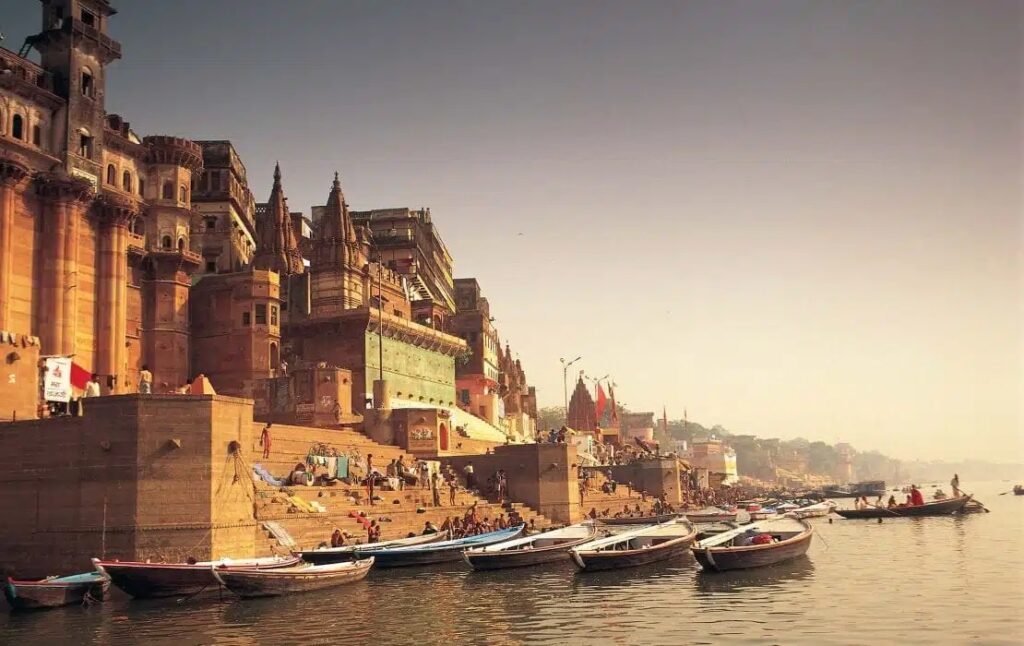
Visit one of the Hindu temples in Varanasi, the Holiest city
Although the temples are not as attractive as the ghats, the truth is that you cannot leave the city without having seen some of the most famous.
Varanasi Golden Temple (Kashi Vishwanath Temple)
It is known by this name because of its gold cover. We are talking about the Kashi Vishwanath temple, which is located in an alley in the vicinity of Manikarnika Ghat. You will realize that you have arrived because of the long lines to access it and the military access control.
The temple dates back to the end of the 18th century, although it is not the original since it has undergone several reconstructions. It is dedicated to Shiva and contains one of the 12 most sacred lingams (a representation of the Hindu deity Shiva used for temple worship) in India. Maharani Ahilyabai Holkar of Indore and Maharaja Ranjit Singh of Amritsar were the ones who ordered its construction and donated the ton of gold that covers the dome.
The entry of non-Hindus to the temple is prohibited, as is cutting the queue and attempting to enter. Therefore, you will have to settle for observing it from the outside.
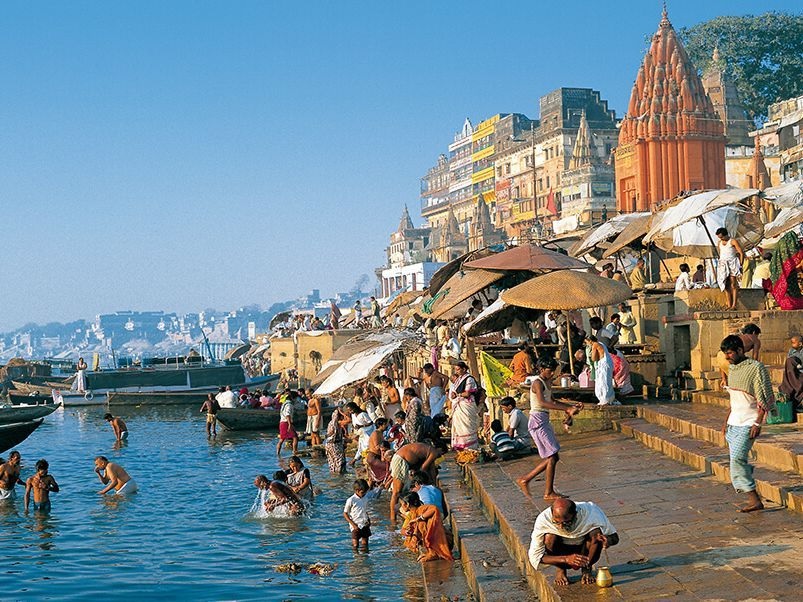
Durga Kund Mandir in Varanasi the Holiest city
This space dedicated to the goddess Durga (wife of Shiva) is also known as the Monkey Temple, because there are usually many of these animals roaming around.
Its construction dates back to the 18th century and was carried out in the Nagara style. It is characterized by its intense red color and the large sacred pond outside, which in ancient times was connected to the Ganges. The image of Durga is represented mounted on a lion and with multiple arms carrying weapons of war. According to legend, the image was already there before the temple was built.
Annapurna Mandir, Varanasi the Holiest city
It is another temple dedicated to the wives of Shiva. In this case, we are talking about Parvati, the goddess of food.
Annapurna Mandir dates back to the 18th century and was also built in the Nagara style, inside the historic quarter of the city. The golden image of Annapurna is only displayed on the day of Govardhan Puja (November 15, 2020), on which believers offer vegetarian food to the goddess.
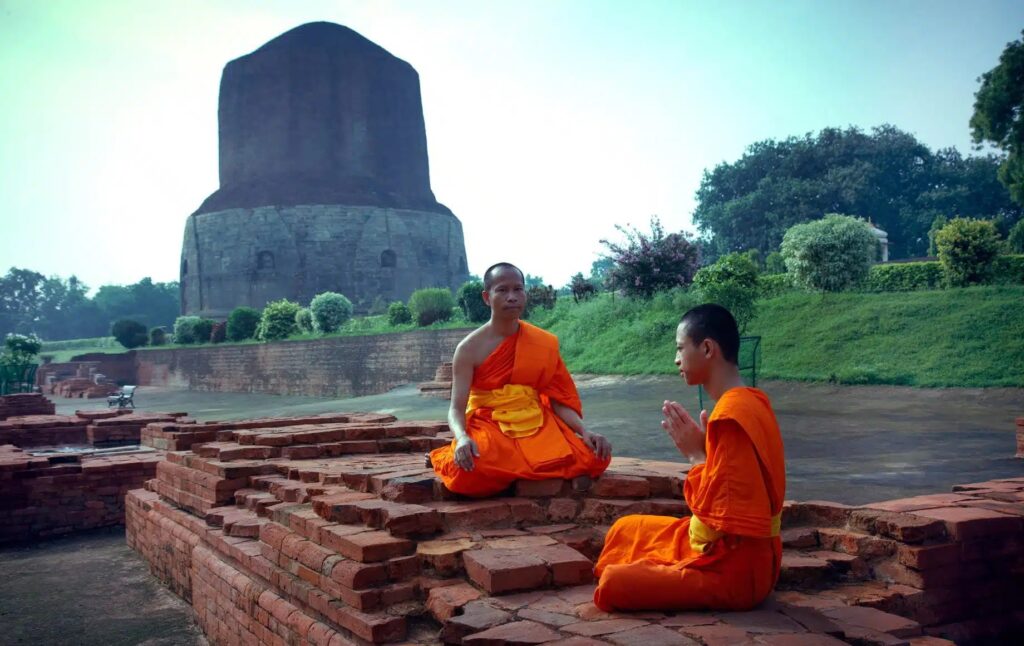
Other places to see in Varanasi, the Holiest city
Although the main attraction of the city is seeing how life revolves around the ghats, there are other corners that if you have time you can visit.
One of them is the market which, like in every Indian city, is an explosion of smell, noise and color. At the stalls you will find whatever you are looking for, from food to clothing. In addition, they are always good places to get in touch with the locals and their customs.
Another thing to do in Varanasi is visit a silk factory, which are all in the same area and are easily accessible by tuk tuk. They carry out guided tours where they instruct tourists in the entire production process. If you are looking to do something more relaxed, then this is one of the best options.

Sarnath Excursion in Varanasi the Holiest city.
Being in Varanasi, you cannot miss the opportunity to visit neighboring Sarnath. Just as our destination today is a pilgrimage center for Hindus, Sarnath is for Buddhism. This holy city is one of the four that are related to the life of Buddha. Lumbini, in Nepal, would have been his birthplace; Bodh Gaya (in India) the place where he achieved enlightenment; Sarnath where he gave his first sermon and Kushinagar (also India) where he died.
In the year 532 B.C. It was when Buddha preached his first sermon to his 5 disciples, giving rise to the birth of Dharma (the law that governs Buddhism) and Shanga (the Buddhist community). Today, thousands of tourists come to visit this historic site and all it has to offer.
In Sarnath, you can visit the main sanctuary, called Mulagandhakuti, Varanasi the Holiest city which is where it is believed that Buddha used to sit and meditate. Also famous is Ashoka’s Pillar, built to commemorate Emperor Ashoka’s visit to the city. Another attraction is the Dhamekh Stupa which is said to be the exact place where Buddha preached the famous sermon. Around this building and in its side gardens hundreds of faithful gather to make their prayers.
Be sure to visit the city with this private excursion to Sarnath.
Thankyou For Checking Our Page Varanasi the Holiest city
By Delighted Journey


